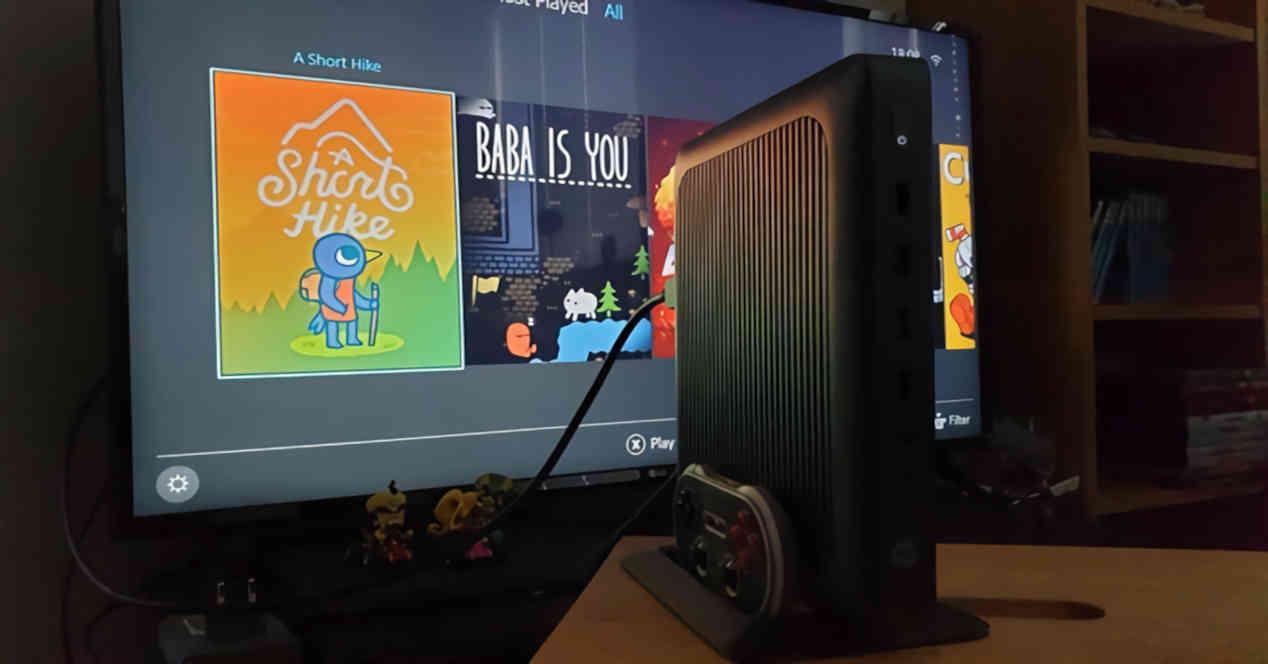Why is a MiniPC better for retrogaming?
For some time now we’ve seen how retrogaming hardware has emerged based on low-end smartphone technology, which has enough power to emulate video game systems up to the mid-90s without performance issues. or emulation, but it goes beyond the first PlayStation and see how the problems appear both on one side and on the other. The other alternative is the Mister FPGA, but due to its limitation in the number of logic gates to be configured, it cannot go much further and it is a solution that can be called upon without fear of being mistaken in a pure niche.
The ideal would be to be able to mount a PC there. The problem? Well, the grace is being able to play in the living room and a tower is always cumbersome and uncomfortable in that respect. Fortunately, for years there has appeared what we colloquially call MiniPC or NUC, which can be placed taking up much less space than a classic PC. It’s also a much better option than having collections of classic consoles taking up space at home, especially now that retro speculators are raising their prices.
Additionally, you won’t experience the scanline issue on consoles with analog video output, and you’ll be able to play games at higher resolutions than on the original hardware, as many emulators have the capability to do so. make. at a higher resolution than the original material. Of course, don’t expect miracles either, many games are already several years old.
How powerful should a MiniPC be for retrogaming?
Well, it depends on the systems we want to emulate, and therein lies the problem in terms of performance. Since if we are talking about 8 and 16 bit systems, a simple TV Box with a little modification will suffice. These aren’t PC-based and cost a fraction of what the cheapest MiniPC might cost you. In fact, today if we want to emulate any retro system that appeared before the first PlayStation, we don’t need to buy a PC.
From the consoles of the second half of the 90s we start to need more performance and most televisions and even the popular Raspberry Pi 4 fall short, and if we move on to the generation of the first decade of the years 2000 is when we need to switch to PC. Especially since for processors with ARM instructions and register sets, there is no decent PlayStation 2 emulator.
It is precisely now, when the consoles of twenty years ago are beginning to fail after many years, with these off the market and with speculators running free, that is, when one has a MiniPC for retrogaming to play old consoles, but not classics from the 80s and 90s, but the one from the early 2000s.
CPU power and graphics matter
And this is where we come to the question of performance in the face of emulation, the large number of MiniPCs in NUC format which generally rely on a low-end processor from Intel and sometimes even from AMD. The problem with these MiniPCs is that when it comes to emulation they are not an advantage if we take into account the power they offer us, since most have been created for office tasks. Many of them are equipped with a very low power integrated GPU, especially those from Intel. Instead, AMD, through the technology of its Radeon graphics, has shown that this part is covered, at least in theory, we’ll see later how it really isn’t.
We also cannot leave out the CPU, in old consoles and systems custom hardware is used that has no equivalent on PC and requires emulation through the main processor. Therefore, we will not only need the graphics to be powerful to achieve the best possible emulation, especially in the most advanced systems due to the complexity of their architectures and the fact that in most cases it is the CPU that needs to emulate much of the hardware itself, not just the CPU.
Are MiniPCs good for retrogaming?
When we decided to write this article, our goal was to find a MiniPC that would allow us to do the following: emulate early 2000s consoles, specifically the SONY PlayStation 2 and Nintendo GameCube without performance issues and if you rush us, we can also Wii. However, their high price made us even more demanding, and given the advances in emulating much more powerful systems, we decided to test them at a higher level. How does it perform when it comes to emulating HD consoles?
For this we have chosen three different models, two of which are MiniPCs that do not have an integrated graphics card and are based on Ryzen APUs of different generations. The third, on the other hand, is an Intel NUC with an RTX 2060 inside and honestly, we were extremely disappointed with the performance they offer for the price they have.
Mini PC AMD Ryzen 5 3450U
The retrogaming MiniPC that tops the list is powered by an AMD Ryzen 7 3750H processor, featuring a 2.3GHz 4-core, 8-thread processor based on the first-generation Zen architecture paired with an AMD Vega GPU 10 Compute Units. GHz, all with dual-channel DDR4-2400 memory.
It’s a great system if we want to emulate systems like the GameCube or the Wii, as it emulates high-resolution games without any performance issues or frame drops at resolutions as high as 1440p. On the other hand, when it comes to emulating the PlayStation 2 through the popular PCSX2, we’re going to have to settle for native resolution in the vast majority of games. If you want to run the games in 720p, you will have to perform speed hacks for the emulator, so it is not powerful enough.
And what about more powerful consoles? On PS3 we will not be able to play all the games, the less technically demanding ones we will run without problem, but forget to be able to play the heavyweights of the console in conditions with this configuration. The same thing happens when it comes to emulating the Wii U, you won’t be able to emulate the whole catalog and you’ll have to settle for the simplest games.
MINI FORUM Elite HX90
This MiniPC is ideal for retrogaming thanks to the use of an AMD Ryzen 9 5900HX with 8 cores and 16 threads of Zen 3 architecture at 3.3 GHz with a Boost at 4.6 GHz and an integrated AMD Radeon Vega GPU with 8 compute units at 2.1 GHz. As for the RAM, we have 16 GB DDR4-3200 in dual channel. So clearly we are not facing a beast in terms of gaming PC, but in terms of emulation. And what about its performance? It can seamlessly emulate anything you throw at it that was released before 2005.
The problem comes when we talk about emulating the so-called systems in HD. For example, if we take CEMU, the emulator of Nintendo’s ill-fated Wii U, we’ll see that the game can maintain 30 FPS with some boosts to just over 40 if we’re playing at 900p, which is the resolution that the game a in TV mode on the Nintendo Switch. On the other hand, if we decide to play it in Full HD, we can find ourselves in the orbit of 20 FPS. .
However, it has no problem emulating games from the early 2000s generation, so if you want to have a system to call back your games to classic consoles like PlayStation 2 or GameCube, this is a great system for that. . It remains to be seen whether its price of more than 1,000 dollars is worth it for this task.
Intel NUC PHKi7CAA1
The powerful Intel NUC based on its laptop Tiger Lake-H processors combined with a GeForce RTX 2060 with 6 GB of memory is one of the options to consider and it is the most powerful hardware you can find. The problem is that its price explodes and is placed at almost 2000 dollars, which even with the inflated price of the RTX 2060 today, we can find them for 600 dollars, it seems exaggerated to us no matter how much it carries an eleventh-generation i7 from Intel, but it doesn’t use hardware for desktops, but for laptops, hence the high price.
Its powerful GPU will allow us to play most of the PS3 catalog at 4K and at a constant 60 FPS in the vast majority of games, however there are exceptions like Killzone 3 where instead of settling at 60 FPS it will do so at a little more than 30 The popular The Last of Us which is between 20 or 30 frames per second, curiously the speed at which the original console was going. What sets us back? The high price of its hardware for the performance it offers.
So what is the best option?
We’re not going to point fingers at anyone, but manufacturers of MiniPCs with gaming graphics cards know that their systems aren’t good enough to compete with a conventional tower PC, nor could they compete in performance with a well-assembled HTPC of the mini type. -ITX. . Unsurprisingly, we can manage to build such a computer for parts and give us the performance of the Intel NUC with the RTX 2060 for a fraction of the price.
The initial goal at the time of writing this article was to decide which was the best MiniPC for retrogaming, but after testing the performance of some of them, our conclusion is clear. We do not recommend them, especially when we have AMD which has just released its Ryzen 6000 APUs on the market with RDNA 2 as GPU and double the graphics performance. We have no doubt that when the Ryzen 6000G, the desktop version of the AM4 chipset, it will be possible for us to build ourselves a MiniPC with much higher performance and a lower price for us than the MiniPCs that are now in the market.
Table of Contents
















